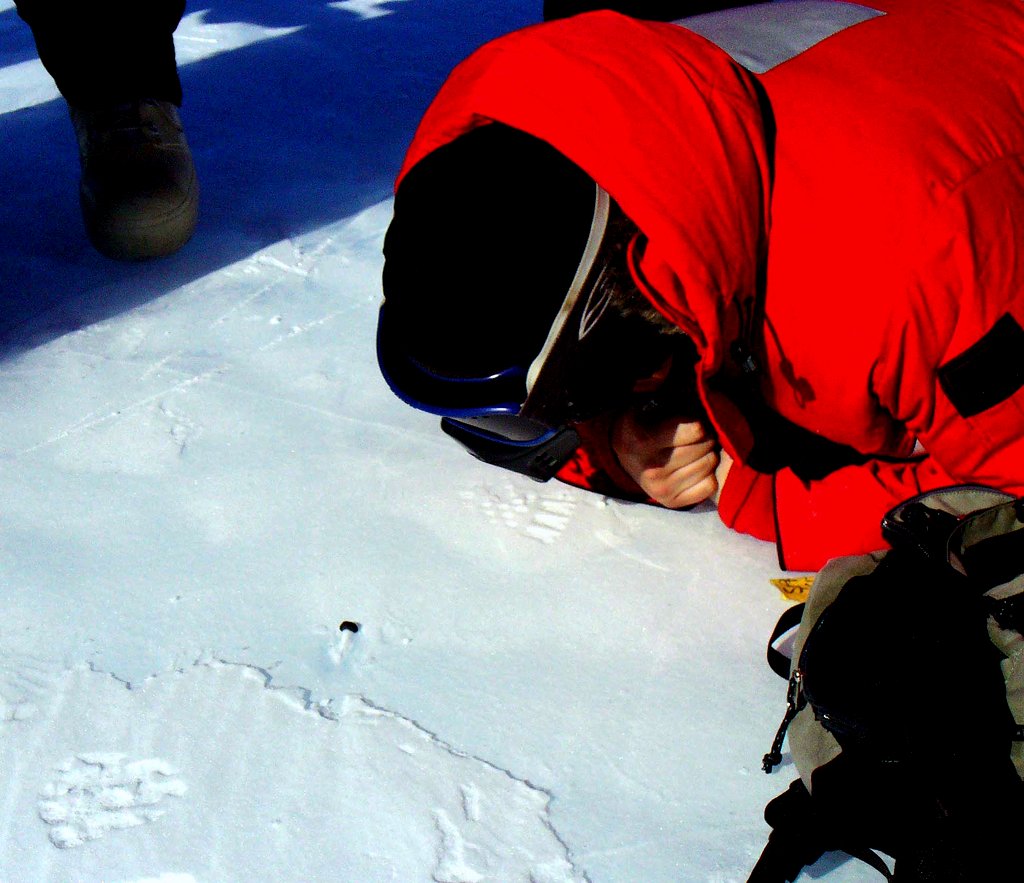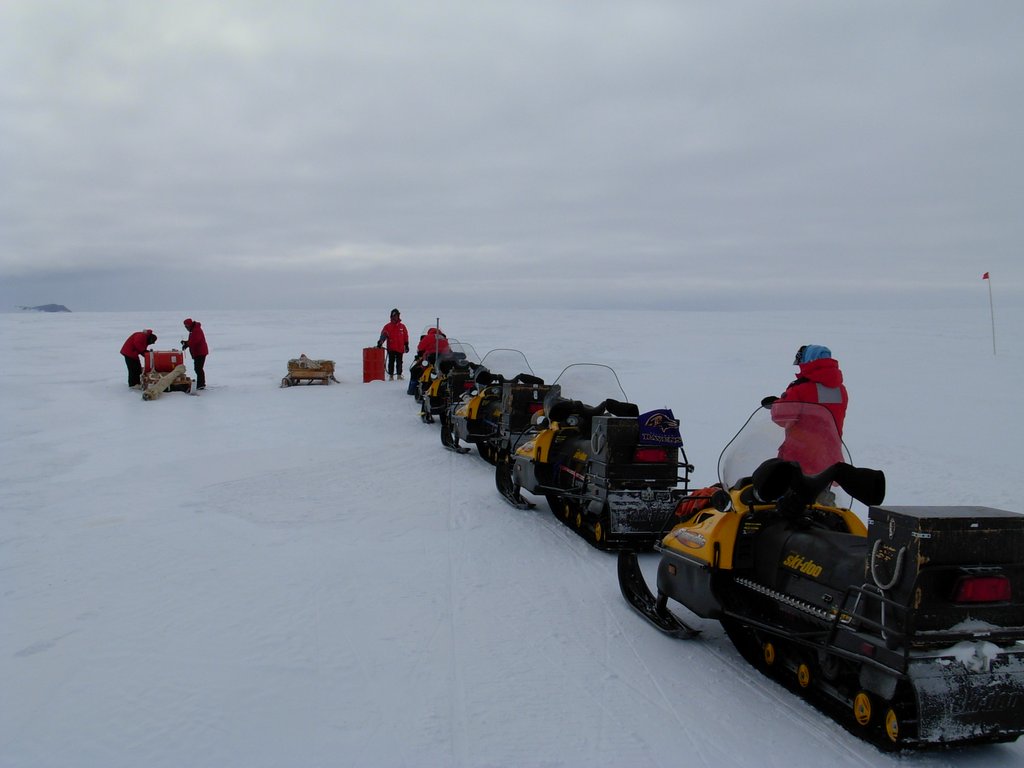First meteorite
Today we searched blue ice glaciers for meteorites. Blue glacier ice is old, made from compacted snow and found in multi square kilometer areas in the Antarctic interior. Blue ice is where meteorites are found (and preserved) in concentrations well above their intrinsic fall rate. Blue ice is the reason why we are here.
We search, once again, using our mechanized sledge-dog equivalents. Forming a classic search line at the base of a blue ice region, we slowly drive across with our snow mobiles, looking for any black spot. If you see a black spot, it is a rock. If you find a rock, there is a good chance it is a meteorite. There are many theories for why this is so, mainly designed to satisfy the techno-mind of man. The bottom line is that meteorites are somehow concentrated and preserved in these blue ice regions. We are here to harvest these bits of extra-terrestrial rocks, each in its own way a small piece of the cosmic puzzle we find ourselves inserted within.

First meteorite; a small aerodynamic shaped button.
Propped up on our knees to improve our visibility, we advance over the irregular surface of robin egg blue with our search line of snowmobiles. The snow mobiles take a real pounding and in turn, pass it on to us. The wind in the Antarctic interior has a special name; the Katabatics. Driven by masses of cold dense air, they blow everywhere northwards towards the coast where it is (relatively speaking) warmer. These winds in the summertime blow at 30 to 60 kilometers per hour and decrease the effective temperature for us from a reasonable -20 C to well below -40 (at -40, it does not matter what temperature scale you use), something that will frost bite bare skin in a matter of minutes. Relatively speaking, -20 seems warm. Man and women alike, as if Nature’s version of affirmative action, grow beards of fuzzy ice around our balaclavas, turning everyone into a personified version of old man frost. Even though we are chilled, the realization of where we are and what we are doing drives us on, warming at least the soul and the spirit.

Collecting a medium-sized meteorite.
One hundred meters away, one of our team mates is waving hands over head, the signal for “Come to Me”. It means that person has found some bit of interesting rock, perhaps a meteorite, and needs a second opinion. We all converge to the spot and after a detailed look by our experts, is proclaimed “Its a Rock”. We resume our search. Sometime later, another hand signal is seen. Again, another standard rock is found. This is not to be confused with crying wolf; this is all a valid part of searching. We leave no rock unturned.
Another waving hand is seen, but this time there was a certain fever, a certain energy, that said this is something different. It happened to be from one of our teammates who is a meteorite expert. We all converge to the spot and there in the ice is a small button of black rock. This rock looked different than just a rock; it had a special character that said it was not of Earth. Glazed with black patina, there were crazed marks as if it had been fired in a kiln at the wrong temperature. It had an odd shape, sculpted by a fiery entry into Earth’s atmosphere and naturally shaped into something similar to what rocket engineers design for the heat shields on spacecraft. Yes, this bit of rock is definitely not of Earth.
With our first meteorite, we forgot about the cold while faces lit up with the smiling excitement of a child. Now it is time to get to work. The process of collection is as rigorous as we can make considering the location and working conditions. We record its location via GPS, take a photograph as it is found with sample number and length scale visible in the image. We write a description in the log book. Only then do we pick it up with sterilized tongs, and place it in a Teflon bag. A metal stamped sample number goes into the bag, folded in a separate compartment. The bag is sealed with freezer tape (normal tape does not work at this temperature) and placed in a backpack. All meteorites are kept frozen so as not to have contact with liquid water (this is easy to do while in the field). They are stored in freezer boxes in camp (just in case it might warm up above freezing) and ultimately shipped back to NASA Johnson Space Center in freezer storage. They are not allowed to thaw until they are placed within what was the original Lunar Receiving Laboratory under conditions fitting for extra-terrestrial material. This treatment may seem excessive, however these precious bits of rock can tell us stories about our solar system and we do not want to alter the possible outcome by careless contamination from human contact.

An aerodynamically shaped meteorite, sculptured by its atmospheric entry, that looks not unlike the heat shield on a space capsule.
It takes four people working with numb fingers a few minutes for the whole process of collection. Then we return to our snow mobiles and onwards in search of another galactic Easter egg.
This day, our first day of searching, we found four meteorites in an area about two square kilometers, an amazing number considering the rather small area of search and the intrinsic fall rate. We drive back to camp cold and tired. We are ready for a hot meal and a cold sleeping bag that will not be warm until after you have been inside for a few minutes.
But first we have to feed our mechanized sledge dogs. We pumped gas, tightening bolts shaken loose in the undercarriage, and put them to bed with the same care that an explorer 100 year ago might have done with his sledge dog team. We realize independent of the technology of the time that our very existence depends on our ability to travel. As a last touch, we tuck them away with snow covers, protection from the Katabatic winds, which can pack everything from the air intakes to the cylinder cooling fins with snow that sets up seemingly as hard as cement.
Only after our mechano-dogs are put to bed do we do the same with ourselves. The howling wind shaking our Scott tent becomes our ever present lullaby.

Feeding our mechano-dogs. We tighten the drive train bolts and fuel up at the end of every day before we settle into our sleeping bags.